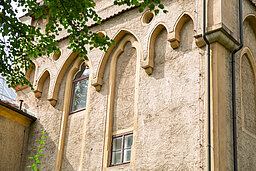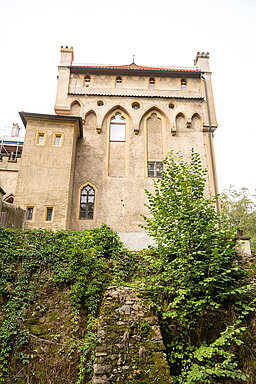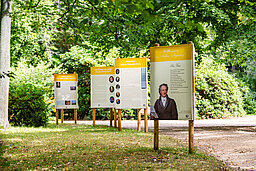

![[Translate to English:] | Die Filmtastischen [Translate to English:]](/fileadmin/_processed_/0/c/csm_000821_KE_Schloss_Seifersdorf_Wachau_ffc2b21ca0.jpg)
From the mid-18th century, Seifersdorf Castle in Wachau was a center of high culture. Writers such as Johann Wolfgang von Goethe, painter Caspar David Friedrich and architect Friedrich Schinkel were welcome guests of the Counts of Brühl, who owned the castle until its expropriation in 1945. Since 2005, Förderverein Seifersdorfer Schloss e.V. has been working to preserve the castle and regularly organizes lectures, cinema evenings, readings and other events for the public.
No regular opening hours, guided tours by appointment
Keine regulären Öffnungszeiten, Führungen nach Vereinbarung
Auto: Auf der B6 Richtung Seifersdorf fahren, dann der Beschilderung zum Schloss folgen.
Öffentliche Verkehrsmittel: Zug nach Bautzen und Bus nach Seifersdorf nehmen. Vom Busbahnhof kann ein Taxi zum Schloss genutzt werden.
Die Ursprünge von Schloss Seifersdorf bei Radeberg nordöstlich von Dresden reichen bis ins 12. Jahrhundert zurück. Doch an Bedeutung gewinnt es erst mit der Übernahme durch Hans Moritz Graf von Brühl im Jahr 1774. Denn mit ihm und seiner Frau Christina, genannt „Tina“, zieht der Geist der Aufklärung in das ehemalige Rittergut ein. Seifersdorf wird zum geistig-kulturellen Zentrum.
Besonders eng verbunden sind der Graf und die Gräfin, die zum Freundeskreis der Weimarer Klassik gehören, dem Dichter Johann Wolfgang von Goethe. Es gibt regen Briefkontakt, den Sohn Carl später fortsetzen wird, sowie regelmäßige Treffen in Weimar und Karlsbad, an denen auch Johann Gottfried Herder teilnimmt. Im Garten des Herrenhauses in Seifersdorf lässt die Familie von Brühl Goethe zu Ehren ein Denkmal errichten. Die Anna Amalia gewidmete Statue wird nur einen Spaziergang vom Schloss entfernt, im Seifersdorfer Tal, aufgestellt. Die Gestaltung des idyllisch gelegenen Tals, das als einer der schönsten und ersten Landschaftsparks Europas gilt, geht auf Tina von Brühl zurück. Bis heute zeugen zahlreiche Denkmale und Erinnerungstafeln von der Zeit, als sich die großen Dichter und Denker hier zum Gedankenaustausch im Schatten exotischer Bäume trafen.
Zu den gern gesehenen Gästen auf Schloss Seifersdorf gehören damals unter anderem Christoph Martin Wieland, Gottfried Schadow und die Brüder Theodor und Gottfried Körner sowie in späteren Jahren auch der Komponist Carl Maria von Weber. Ihnen eng verbunden ist Sohn Carl von Brühl, der noch auf dem Stammsitz der Familie im heutigen Brody (Polen) geboren wird. Als Tina von Brühl im Jahr 1816 stirbt und er die Grundherrschaft über Schloss Seifersdorf übernimmt, ist er bereits Preußischer Generalintendant der königlichen Schauspiele in Berlin. In der Hauptstadt lernt Carl den Architekten Karl-Friedrich Schinkel kennen, nach dessen Plänen er Schloss Seifersdorf im neugotischen Stil umbauen lässt.
Da Schloss Seifersdorf aktuell grundlegend saniert wird, wurden Veranstaltungen unter anderem in den Schlosspark verlegt. Dort finden die Besuchenden auch 40 Schautafeln aus der Dauerausstellung „Das sächsische Weimar?! Schloss Seifersdorf und das Seifersdorfer Tal in ihrer kulturhistorischen Bedeutung“, die gerade neu konzipiert wird. Erste Teile des Schlosses sollen voraussichtlich Ende 2025 wieder für die Öffentlichkeit zugänglich sein. Die gesamte museale Umgestaltung von Schloss Seifersdorf wird vermutlich bis Ende 2026 dauern. Der Schlosspark ist ebenso wie das Seifersdorfer Tal ganzjährig geöffnet.
The origins of Seifersdorf Castle near Radeberg, north-east of Dresden, date back to the 12th century. However, it only gained significance when Hans Moritz Count von Brühl took over the castle in 1774, as he and his wife Christina, known as “Tina”, brought the spirit of the Enlightenment to the former manor. Seifersdorf becomes an intellectual and cultural center.
The Count and Countess, who belonged to the circle of friends of Weimar Classicism, were particularly close to the poet Johann Wolfgang von Goethe. There was lively correspondence, which their son Carl would later continue, as well as regular meetings in Weimar and Karlovy Vary, which Johann Gottfried Herder also attended. The von Brühl family had a monument erected in Goethe's honor in the garden of the manor house in Seifersdorf. The statue dedicated to Anna Amalia is erected just a short walk from the castle, in the Seifersdorf valley. The design of the idyllic valley, which is considered one of the most beautiful and first landscape parks in Europe, goes back to Tina von Brühl. To this day, numerous monuments and commemorative plaques bear witness to the time when the great poets and thinkers met here to exchange ideas in the shade of exotic trees.
At the time, Christoph Martin Wieland, Gottfried Schadow and the brothers Theodor and Gottfried Körner were among the most welcome guests at Seifersdorf Castle, as was the composer Carl Maria von Weber in later years. Their son Carl von Brühl, who was born at the family's ancestral seat in what is now Brody (Poland), was closely associated with them. When Tina von Brühl died in 1816 and he took over the estate of Seifersdorf Castle, he was already the Prussian General Director of the Royal Theatre in Berlin. In the capital, Carl met the architect Karl-Friedrich Schinkel, according to whose plans he had Seifersdorf Castle rebuilt in the neo-Gothic style.
As Seifersdorf Castle is currently undergoing extensive renovation, events have been moved to the castle park, among other places. Visitors will also find 40 display panels from the permanent exhibition “The Saxon Weimar? Seifersdorf Castle and the Seifersdorf Valley in their cultural and historical significance”, which is currently being redesigned. The first parts of the castle are expected to be open to the public again at the end of 2025. The entire museum conversion of Seifersdorf Castle is expected to take until the end of 2026. The castle park is open all year round, as is the Seifersdorf Valley.



